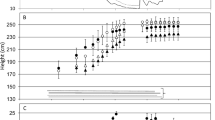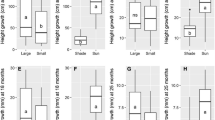Abstract
In many semi-arid environments of Mediterranean ecosystems, white poplar (Populus alba L.) is the dominant riparian tree and has been used to recover degraded areas, together with other native species, such as ash (Fraxinus angustifolia Vahl.) and hawthorn (Crataegus monogyna Jacq.). We addressed three main objectives: (1) to gain an improved understanding of some specific relationships between environmental parameters and leaf-level physiological factors in these riparian forest species, (2) to compare the leaf-level physiology of these riparian species to each other, and (3) to compare leaf-level responses within native riparian plots to adjacent restoration plots, in order to evaluate the competence of the plants used for the recovery of those degraded areas. We found significant differences in physiological performance between mature and young white poplars in the natural stand and among planted species. The net assimilation and transpiration rates, diameter, and height of white poplar plants were superior to those of ash and hawthorn. Ash and hawthorn showed higher water use efficiency than white poplar. White poplar also showed higher levels of stomatal conductance, behaving as a fast-growing, water-consuming species with a more active gas exchange and ecophysiological competence than the other species used for restoration purposes. In the restoration zones, the planted white poplars had higher rates of net assimilation and water use efficiency than the mature trees in the natural stand. We propose the use of white poplar for the rapid restoration of riparian vegetation in semi-arid Mediterranean environments. Ash and hawthorn can also play a role as accompanying species for the purpose of biodiversity.









Similar content being viewed by others
References
Barta C, Loreto F (2006) The Relationship between the Methyl-Erythritol Phosphate Pathway Leading to Emission of Volatile Isoprenoids and Abscisic Acid Content in Leaves. Plant Physiology 141:1676–1683
Chambers JL, Hinckley TM, Cox GS, Metcalf CL, Aslin RG (1985) Boundary-line analysis and models of leaf conductance for four oak-hickory forest species. Forest Science 31(2):437–450
Cheeseman JM, Lexa M (1996) In: N.R: Baker (ed.), Advances in Photosynthesis: Volume 5, Photosynthesis and the Environment. Kluwer Academic Publishers, Dordrecht, The Netherlands, Pages 223–240
Disalvo AC, Hart SC (2002) Climatic and stream-flow controls on tree growth in a Western montane riaparian forest. Environmental Management 30(5):678–691
Fischer DG, Hart SC, Whitham TG, Martinsen GD, Keim P (2004) Ecosystem implications of genetic variation in water-use of a dominant riparian tree. Oecologia 139:288–297
Foster JR (1992) Photosynthesis and water relations of the floodplain tree, boxelder (Acer negundo L.). Tree Physiology 11:133–149
Hart SC, Disalvo AC (2005) Net primary productivity of a western montane riparian forest: potential influence of stream flow diversion. Madroño 52(2):79–90
Hetherington AM, Woodward FI (2003) The role of stomata in sensing and driving environmental change. Nature 424:901–908
Horton JL, Kolb TE, Hart SC (2001a) Leaf gas exchange characteristics differ among Sonoran Desert riparian tree species. Tree Physiology 21:233–241
Horton JL, Kolb TE, Hart SC (2001b) Physiological response to groundwater depth varies among species and with river flow regulation. Ecological Applications 11(4):1046–1059
Horton JL, Kolb TE, Hart SC (2001c) Responses of riparian trees to interannual variation in ground water depth in a semi-arid river basin. Plant Cell and Environment 24:293–304
Kazda M, Salzer J, Reiter I (2000) Photosynthetic capacity in relation to nitrogen in the canopy of a Quercus robur, Fraxinus angustifolia and Tilia cordata flood plain forest. Tree Physiology 20:1029–1037
Kolb TE, Hart SC, Amundson R (1997) Boxelder water sources and physiology at perennial and ephemeral stream sites in Arizona. Tree Physiology 17:151–160
Kozlowski TT, Pallardy SG (1997) Physiology of woody plants. 2nd Edn. Academic Press, San Diego, 411 pp
Landsberg JJ, Gower ST (1997) Applications of Physiological Ecology to Forest Management. Academic Press, San Diego, 354 pp
Noormets A, Sober A, Pell EJ, Dickson RE, Podila GK, Sober J, Isebrands JG, Karnosky DF (2001) Stomatal and non-stomatal limitation to photosynthesis in two trembling aspen (Populus tremuloides Michx.) clones exposed to elevated CO2 and/or O3. Plant Cell and Environment 24:327–336
Pathre U, Sinha AK, Shirke PA, Sane PV (1998) Factors determining the midday depression of photosynthesis in trees under monsoon climate. Trees 12:472–481
Peña-Rojas K, Aranda X, Fleck I (2004) Stomatal limitation to CO2 assimilation and down-regulation of photosynthesis in Quercus ilex resprouts in response to slowly imposed drought. Tree Physiology 24:813–822
Pereira JS, Kozlowski TT (1977) Variations among woody angiosperms in response to flooding. Physiologia Plantarum 41:184–192
Schaeffer SM, Williams DG, Goodrich DC (2000) Transpiration of cottonwood/willow forest estimated from sap flux. Agricultural and Forest Meteorology 105:257–270
Smith SD, Devitt DA, Sala A, Cleverly JR, Busch DE (1998) Water relations of riparian plants from warm desert regions. Wetlands 18:687–696
Snyder KA, Williams DG (2000) Water sources used by riparian trees varies among stream types on the San Pedro River, Arizona. Agricultural and Forest Meteorology 105:227–240
Sparks JP, Black RA (1999) Regulation of water loss in populations of Populus trichocarpa: the role of stomatal control in preventing xylem cavitation. Tree Physiology 19:453–459
Wang X, Curtis PS, Pregitzer KS, Zak DR (2000) Genotypic variation in physiological and growth responses of Populus tremuloides to elevated CO2 concentration. Tree Physiology 20:1019–1028
Will RE, Teskey RO (1997) Effect of irradiance and vapour pressure deficit on stomatal response to CO2 enrichment of four tree species. Journal of Experimental Botany 48(317):2095–2102
Wittig VE, Bernacchi CJ, Zhu XG, Calfapietra C, Ceulemans R, Deangelis P, Gielens B, Miglietta F, Morgan PB, Long SP (2005) Gross primary production is stimulated for three Populus species grown under free-air CO2 enrichment from planting through canopy closure. Global Change Biology (2005) 11:1–13
Acknowledgments
We thank the Spanish Ministry of Education and Science for funding the research project, RTA01-009. Maria F. Martínez-Chacón was recipient of a scholarship from the Madrid Institute of Agricultural Research (IMIDRA). We also thank Pru Brooke-Turner for the linguistic revision of the manuscript.
Author information
Authors and Affiliations
Corresponding author
Rights and permissions
About this article
Cite this article
Manzanera, J.A., Martínez-Chacón, M.F. Ecophysiological Competence of Populus alba L., Fraxinus angustifolia Vahl., and Crataegus monogyna Jacq. Used in Plantations for the Recovery of Riparian Vegetation. Environmental Management 40, 902–912 (2007). https://doi.org/10.1007/s00267-007-9016-z
Published:
Issue Date:
DOI: https://doi.org/10.1007/s00267-007-9016-z




